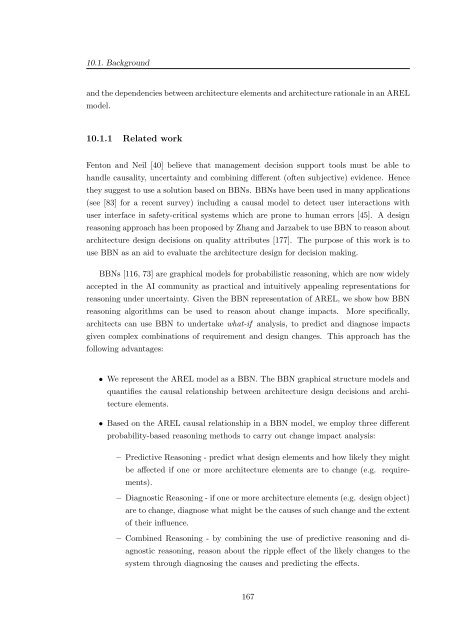A Rationale-based Model for Architecture Design Reasoning
A Rationale-based Model for Architecture Design Reasoning
A Rationale-based Model for Architecture Design Reasoning
Create successful ePaper yourself
Turn your PDF publications into a flip-book with our unique Google optimized e-Paper software.
10.1. Background<br />
and the dependencies between architecture elements and architecture rationale in an AREL<br />
model.<br />
10.1.1 Related work<br />
Fenton and Neil [40] believe that management decision support tools must be able to<br />
handle causality, uncertainty and combining different (often subjective) evidence. Hence<br />
they suggest to use a solution <strong>based</strong> on BBNs. BBNs have been used in many applications<br />
(see [83] <strong>for</strong> a recent survey) including a causal model to detect user interactions with<br />
user interface in safety-critical systems which are prone to human errors [45]. A design<br />
reasoning approach has been proposed by Zhang and Jarzabek to use BBN to reason about<br />
architecture design decisions on quality attributes [177]. The purpose of this work is to<br />
use BBN as an aid to evaluate the architecture design <strong>for</strong> decision making.<br />
BBNs [116, 73] are graphical models <strong>for</strong> probabilistic reasoning, which are now widely<br />
accepted in the AI community as practical and intuitively appealing representations <strong>for</strong><br />
reasoning under uncertainty. Given the BBN representation of AREL, we show how BBN<br />
reasoning algorithms can be used to reason about change impacts. More specifically,<br />
architects can use BBN to undertake what-if analysis, to predict and diagnose impacts<br />
given complex combinations of requirement and design changes. This approach has the<br />
following advantages:<br />
• We represent the AREL model as a BBN. The BBN graphical structure models and<br />
quantifies the causal relationship between architecture design decisions and architecture<br />
elements.<br />
• Based on the AREL causal relationship in a BBN model, we employ three different<br />
probability-<strong>based</strong> reasoning methods to carry out change impact analysis:<br />
– Predictive <strong>Reasoning</strong> - predict what design elements and how likely they might<br />
be affected if one or more architecture elements are to change (e.g. requirements).<br />
– Diagnostic <strong>Reasoning</strong> - if one or more architecture elements (e.g. design object)<br />
are to change, diagnose what might be the causes of such change and the extent<br />
of their influence.<br />
– Combined <strong>Reasoning</strong> - by combining the use of predictive reasoning and diagnostic<br />
reasoning, reason about the ripple effect of the likely changes to the<br />
system through diagnosing the causes and predicting the effects.<br />
167
















